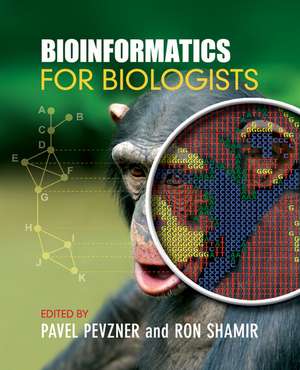Bioinformatics for Biologists
Editat de Pavel Pevzner, Ron Shamiren Limba Engleză Hardback – 14 sep 2011
| Toate formatele și edițiile | Preț | Express |
|---|---|---|
| Paperback (1) | 429.15 lei 6-8 săpt. | |
| Cambridge University Press – 14 sep 2011 | 429.15 lei 6-8 săpt. | |
| Hardback (1) | 1030.42 lei 6-8 săpt. | |
| Cambridge University Press – 14 sep 2011 | 1030.42 lei 6-8 săpt. |
Preț: 1030.42 lei
Preț vechi: 1198.17 lei
-14% Nou
Puncte Express: 1546
Preț estimativ în valută:
197.20€ • 205.12$ • 162.80£
197.20€ • 205.12$ • 162.80£
Carte tipărită la comandă
Livrare economică 14-28 aprilie
Preluare comenzi: 021 569.72.76
Specificații
ISBN-13: 9781107011465
ISBN-10: 1107011469
Pagini: 394
Ilustrații: 37 b/w illus. 105 colour illus. 4 tables
Dimensiuni: 195 x 252 x 22 mm
Greutate: 0.92 kg
Ediția:New.
Editura: Cambridge University Press
Colecția Cambridge University Press
Locul publicării:New York, United States
ISBN-10: 1107011469
Pagini: 394
Ilustrații: 37 b/w illus. 105 colour illus. 4 tables
Dimensiuni: 195 x 252 x 22 mm
Greutate: 0.92 kg
Ediția:New.
Editura: Cambridge University Press
Colecția Cambridge University Press
Locul publicării:New York, United States
Cuprins
Preface; Acknowledgements; Introduction Pavel Pevzner and Ron Shamir; Part I. Genomes: 1. Identifying the genetic basis of disease Vineet Bafna; 2. Pattern identification in a haplotype block Kun-Mao Chao; 3. Genome reconstruction: a puzzle with a billion pieces Phillip Compeau and Pavel Pevzner; 4. Dynamic programming: one algorithmic key for many biological locks Mikhail Gelfand; 5. Measuring evidence: who's your daddy? Christopher Lee; Part II. Gene Transcription and Regulation: 6. How do replication and transcription change genomes? Andrei Grigoriev; 7. Modeling regulatory motifs Sridhar Hannenhalli; 8. How does influenza virus jump from animals to humans? Haixu Tang; Part III. Evolution: 9. Genome rearrangements Steffen Heber and Brian Howard; 10. The crisis of the tree of life concept and the search for order in the phylogenetic forest Eugene Koonin, Pere Puigbò and Yuri Wolf; 11. Reconstructing the history of large-scale genomic changes: biological questions and computational challenges Jian Ma; Part IV. Phylogeny: 12. Figs, wasps, gophers, and lice: a computational exploration of coevolution Ran Libeskind-Hadas; 13. Big cat phylogenies, consensus trees, and computational thinking Seung-Jil Sun and Tiffani Williams; 14. Algorithm design for large-scale phylogeny Tandy Warnow; Part V. Regulatory Networks: 15. Biological networks uncover evolution, disease, and gene functions Nataša Pržulj; 16. Regulatory network inference Russell Schwartz; Index.
Recenzii
'This volume contains a remarkable collection of individually-authored chapters cutting a wide swathe across the field as it is currently constituted. What is noteworthy, aside from the wide angle of the snapshot of today's bioinformatics, something the editors promise to update in future editions, is the innovative and effective pedagogical emphasis apparent throughout … The editors set out to provide a resource for teaching bioinformatics to life science undergraduates, and this is reflected in the language, organization and mathematical restraint of the different chapters … It is highly suitable as a text or reference for bioinformatics courses at the graduate level, for biologists, medical students and computer scientists. Biological naïveté in thinking and writing plagues bioinformatics, and Pevzner and Shamir's Bioinformatics for Biologists offers a wonderful therapy for that condition as well as an effective palliative for life science students' math phobias.' Professor David Sankoff, University of Ottawa
'A serious and valuable effort to bring essential and much-needed training in the computational sciences to students of modern biology.' Michael Waterman, University of Southern California
'This volume represents an excellent [effort] towards creating an interesting and useful introductory bioinformatics text. In its current form it may benefit computational scientists more than biologists, but has the potential to evolve into an invaluable resource for all bioinformaticists, independent of their primary field of study.' Dimitris Papamichail, SIGACT News
'A serious and valuable effort to bring essential and much-needed training in the computational sciences to students of modern biology.' Michael Waterman, University of Southern California
'This volume represents an excellent [effort] towards creating an interesting and useful introductory bioinformatics text. In its current form it may benefit computational scientists more than biologists, but has the potential to evolve into an invaluable resource for all bioinformaticists, independent of their primary field of study.' Dimitris Papamichail, SIGACT News
Descriere
A team of renowned bioinformaticians take innovative approaches to lead biology students from first principles towards computational thinking.






















